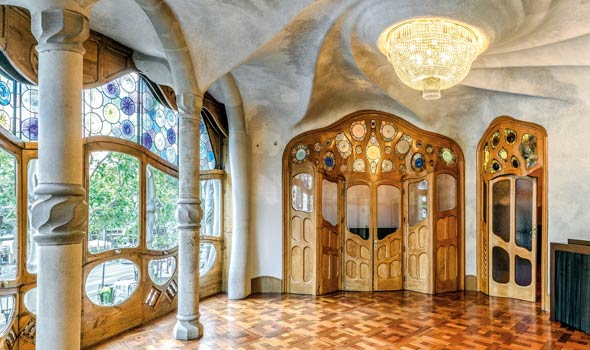A designer who I’ve admired for a long time is the Spanish architect Antoni Gaudi. Gaudi was born in 1852 to a family of boilermakers. This awarded him with a good sense of space as he worked in his family’s workshop growing up. Around 1870, Gaudi left to Barcelona to pursue his studies in architecture. Even at his school, Gaudi had a reputation. Upon the completion of Gaudi’s studies in 1878, the Director of the school, Elies Rogent, famously said, “I do not know if we have awarded this degree to a madman or to a genius; only time will tell.” Time did tell as Gaudi went on to design some of the most iconic and unique buildings in the world, which are still revered to this day.
What I find so fascinating about Gaudi’s work is the clear inspiration from nature and the organics shapes his work takes. One of Gaudi’s work that really emphasizes this is Caso Batllo in Barcelona. Below are shown the façade and the noble floor of Caso Batllo. The colors and shape of the roof make the building look almost like a living creature, maybe a dragon. For the interior of the noble floor, the entire room appears as if it’s almost being drawn into the center of the ceiling at the light. All these unique and organic features make the building seem almost like a part of nature.


Another one of Gaudi’s works that I admire is La Sagrada Familia, a cathedral in Barcelona. This is Gaudi’s masterpiece and is still under construction today, which is incredible considering construction began in 1882. This is a massive work and has a lot of detail but that’s only part of what makes it so fascinating to me.

The design of La Sagrada Familia was inspired by gravity. The way that Gaudi modeled this was by upside down using strings with sand bags attached at different points. As seen below, the model is used to show where the structural forces are distributed. This is such a unique idea that Gaudi was able to successfully implement which is part of what makes him one of my favorite designers.

“Biography of Antoni Gaudi – Casa Batlló by Antoni Gaudí, Barcelona.” Caso Batllo, https://www.casabatllo.es/en/antoni-gaudi/.
“Sagrada Família.” Encyclopædia Britannica, Encyclopædia Britannica, Inc., 24 Jan. 2023, https://www.britannica.com/topic/Sagrada-Familia.
Figure 7-Sagrada Familia Model, from Gaudi 8 – Researchgate. https://www.researchgate.net/figure/Sagrada-familia-Model-from-Gaudi-8_fig6_311321180.


6 Comments. Leave new
I saw this same building in Tel Aviv when I was there a few months ago! It really does look Gaudiesque with the natural form of the façade. Very interesting point you brought up.
I loved learning more about Gaudi and his work. I liked how brought attention to the inspiration of nature and the comparison of the Caso Batllo! It is fascinating that to be great people will think you are a mad man.
People are scared when people or things don’t fit the norm. I think it’s really impressive when people are able to rise above this judgement from others and be great.
I feel like many people are scared when people do things outside of the norm. For people to be truly great, like Gaudi, they have to rise above the judgement of others and blaze their own way.
Wow, what an amazing idea to design a cathedral upside down. Excellent write-up on this designer. You might be interested in this similar work, a building I saw in Tel Aviv: https://www.jpost.com/real-estate/the-crazy-house
I saw this same building in Tel Aviv when I was there a few months ago! It really does look Gaudiesque with the natural form of the facade. Very interesting point you brought up.